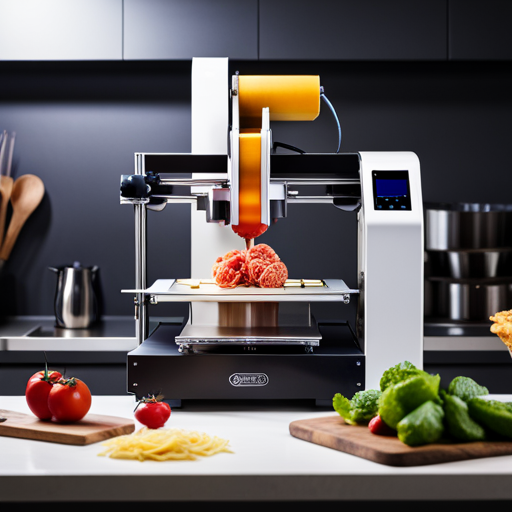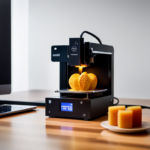In a world where culinary boundaries are constantly being pushed, the emergence of food 3D printing technology has revolutionized the way we think about food preparation. The ability to create intricate and customized edible designs has opened up a realm of possibilities.
This article delves into the realm of versatility in food 3D printing, offering an analytical review of the top printers available. Join us as we explore the cutting-edge features and emerging innovations in this fascinating culinary landscape.
Advancements in Food 3D Printing Technology
The advancements in food 3D printing technology have revolutionized the culinary industry, paving the way for unprecedented innovation and customization in food production.
3D printed cuisine is at the forefront of culinary creativity, offering chefs and food enthusiasts the ability to create intricate and visually stunning dishes that were once only imaginable. This technology allows for the precise layering of ingredients, resulting in dishes with unique textures, shapes, and flavors that elevate the dining experience.
Furthermore, 3D printing enables the production of intricate molds and designs that would be extremely challenging to achieve using traditional methods. Chefs can now push the boundaries of culinary artistry, experimenting with new presentations and flavor combinations that captivate the senses.
The customization possibilities are endless, catering to individual preferences and dietary restrictions with ease. As 3D printing technology continues to advance, it is poised to redefine the way we perceive and experience food, inspiring a new era of culinary exploration and creativity.
Top Features to Consider When Choosing a Food 3D Printer
How can one determine the most suitable food 3D printer for their culinary needs? When choosing a food 3D printer, it is essential to consider several key features. Firstly, examine the 3D printer materials that the machine is compatible with. Some printers may only work with specific types of food-grade materials, such as chocolate or fondant, while others offer a broader range of options, including doughs, cheese, and vegetable purees. The ability to use different materials can significantly impact the variety of food creations possible.
Another crucial factor to consider is printing speed. The printing speed of a food 3D printer can affect the efficiency of food production. Faster printing speeds can be advantageous for commercial kitchens or food businesses looking to increase output without compromising quality. However, it’s important to balance speed with precision and consistency to ensure that the printed food items maintain their desired shape and texture.
Considering these features is pivotal in making an informed decision when selecting a food 3D printer that aligns with specific culinary needs. Now, let’s delve into the review of the best food 3D printers for home use.
Review of the Best Food 3D Printers for Home Use
Delving into the realm of home food 3D printing, it is essential to examine which printers offer the versatility and precision required for culinary enthusiasts. When considering the consumer market, home kitchen 3D food printers need to balance affordability with accessibility, making them suitable for a wide range of users.
Here are the top food 3D printers for home use:
-
Creality CR-100
- Affordable and compact, suitable for beginners
- Offers basic food printing capabilities for simple designs
-
Pinya3 M1
- User-friendly interface, ideal for home kitchen use
- Provides a balance between affordability and quality prints
-
Bocusini
- Tailored for the home consumer market
- Offers a wide range of food printing capabilities at an accessible price point
-
Choc Creator V2.0 Plus
- Specifically designed for chocolate printing
- Suitable for home use with a focus on dessert and pastry creations
These printers cater to the growing demand for food 3D printing in home kitchens, providing accessibility and affordability while maintaining high-quality printing standards.
Transitioning into the subsequent section about ‘industrial-grade food 3D printers: a comprehensive comparison’, it is crucial to explore how these home-use printers compare to industrial-grade options.
Industrial-Grade Food 3D Printers: A Comprehensive Comparison
Transitioning from the review of home kitchen 3D food printers, it is imperative to compare and contrast these consumer-grade options with industrial-grade food 3D printers, examining their capabilities and suitability for professional culinary applications.
Industrial-grade food 3D printers are designed for high volume, precision printing in commercial kitchens, bakeries, and restaurants. These printers are built to handle continuous operation and are equipped with advanced technology to meet the demands of professional food production.
When comparing industrial-grade printers, factors such as printing speed, precision, material compatibility, and customization options are crucial. Printers like the Procusini 4.0 and the Beehex Chef 3D are known for their high precision and ability to produce intricate designs, making them suitable for high-end culinary creations.
On the other hand, the 3D Systems’ ChefJet Pro stands out for its versatility in printing with various ingredients, catering to a wide range of culinary applications. Understanding the performance comparison of industrial-grade food 3D printers is essential for businesses looking to adopt this technology for large-scale food production.
Exploring the Future of Food 3D Printing: Emerging Innovations
Emerging innovations in food 3D printing are reshaping the culinary landscape, offering unprecedented opportunities for creativity and efficiency in professional kitchen environments. The future of food 3D printing holds exciting potential, with several emerging innovations making waves in the industry:
-
Customized Recipes: Food 3D printers are being developed to create personalized, nutritionally tailored meals based on individual dietary needs and preferences. This innovation not only caters to specific dietary requirements but also enhances the overall dining experience by allowing for unique flavor combinations and textures.
-
Sustainable Production: There is a growing emphasis on sustainable practices within the food industry, and 3D printing offers a way to minimize food waste and promote sustainability. Innovations in this area include the use of alternative ingredients and the ability to create intricate designs that optimize ingredient usage.
-
Enhanced Culinary Techniques: Advanced 3D printing technologies are enabling chefs to explore new culinary frontiers by creating visually stunning and intricately designed dishes that were previously unattainable through traditional methods.
-
On-Demand Food Production: 3D printing allows for on-demand production of food items, reducing the need for extensive storage and transportation, ultimately leading to fresher and more efficiently produced meals.
Frequently Asked Questions
Can Food 3D Printers Be Used to Create Personalized Nutritional Meals Based on Specific Dietary Needs?
Personalized dietary needs can be addressed through food 3D printers, allowing for nutritional customization. By using specific ingredients and portion control, these printers can create meals tailored to individual dietary requirements, offering a unique and innovative approach to food production.
Are There Any Safety Concerns or Regulations to Consider When Using a Food 3D Printer at Home?
When using a food 3D printer at home, it’s crucial to consider safety regulations and food printing technology. Health concerns and food safety must be prioritized. Compliance with 3D printing regulations ensures the safe and proper usage of these innovative devices.
What Types of Ingredients Can Be Used in Food 3D Printers, and Are There Any Limitations on the Types of Food That Can Be Printed?
Food 3D printers can use a variety of ingredients, including chocolate, cheese, and dough. However, there are limitations on the types of food that can be printed due to viscosity, texture, and temperature requirements.
How Easy Is It to Clean and Maintain a Food 3D Printer for Home Use?
Cleaning and maintaining a food 3D printer for home use is essential for hygiene and optimal performance. Efficiently cleaning the printer after each use and following maintenance tips, such as regular inspection of components, ensures longevity and food safety.
Are There Any Environmental Impacts or Sustainability Considerations Associated With Food 3D Printing Technology?
Food 3D printing technology presents environmental benefits by reducing food waste and packaging materials. It has the potential to minimize the carbon footprint associated with food production and distribution. Sustainable sourcing of printing materials further contributes to waste reduction.
Conclusion
In conclusion, the field of food 3D printing continues to advance with innovative technologies and features. The top food 3D printers for home use offer a range of capabilities, while industrial-grade printers provide comprehensive solutions for large-scale production.
As emerging innovations continue to shape the future of food 3D printing, the possibilities for creating unique and customizable food products are endless. With the rapid evolution of this technology, the potential for revolutionizing the food industry is immense.

